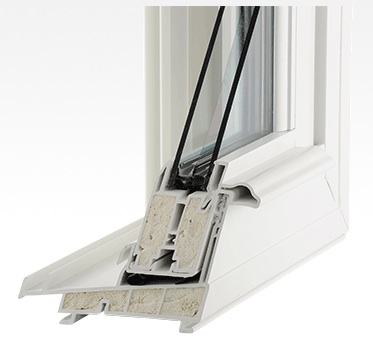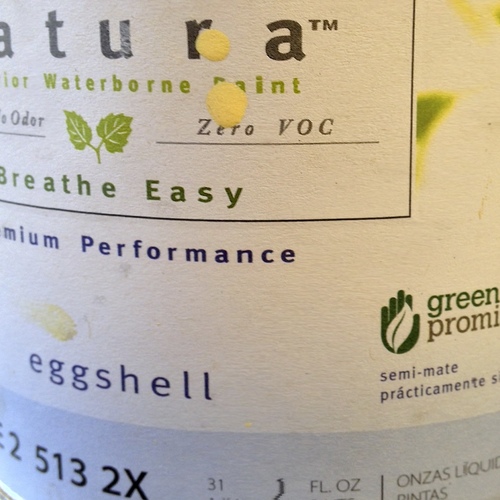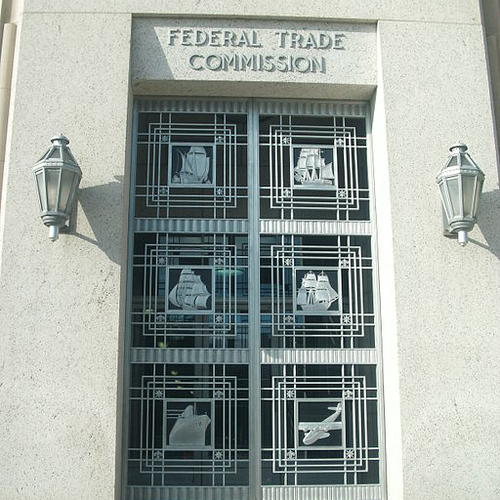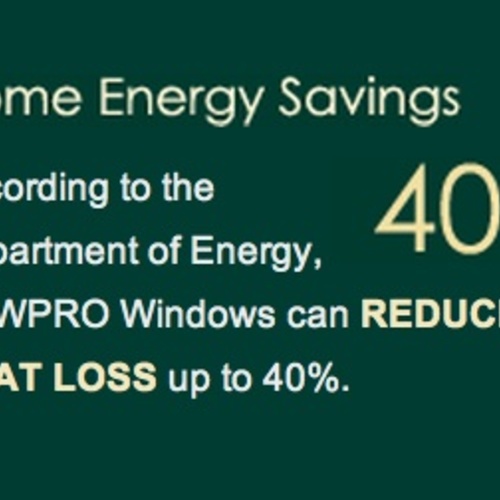
Image Credit: Serious Energy
Because they can be expensive but also critical to the comfort and performance of a house, windows tend to be selected and installed carefully, particularly in custom projects aimed at a high level of energy efficiency. What drove the Federal Trade Commission to issue an administrative complaint against five companies that sell windows billed as energy efficient, though, was that they expanded on concepts of comfort and performance to claim, in marketing materials, that installation of their products would produce a certain level of energy savings.
The marketing materials pledged energy savings of anywhere from 35% to 50%, depending on the company, and offered cash-back guarantees on energy bills if the windows failed to produce the advertised savings. Given the huge range of variables that can come into play in energy performance – from geographic location, shading, and building size to insulation systems and the performance of existing windows – the FTC voted to declare the claims deceptive and unscientific.
Exaggerated claims
One researcher who has looked into the question of energy savings from window replacement is Michael Blasnik. “I’ve looked at a lot of window replacement data,” Blasnik said recently at the Building Energy 12 conference in Boston. “I’ve heard window salespeople say that you can save 50% on your heating bills if you replace all your windows. In fact, the amount of energy saved by replacing all of the windows in a home is generally on the order of 1% to 4% of the heating energy usage.”
Exaggerated marketing claims by companies selling replacement windows have exasperated energy experts for decades. “Window replacement has a 200 to 300 year payback period,” said Blasnik. “A Wisconsin study found that a lot of the expected energy saving is lost by the reduction of solar gain. Most replacement windows have low-solar-gain glazing, so maybe half the energy saving is gone due to the reduction in solar gain. I tell people, go ahead and replace your windows if you want, but don’t expect significant energy savings.”
A path to compliance
Late last month, the FTC announced that it had settled charges that the five companies – Gorell Enterprises; Long Fence & Home; Serious Energy; THV Holdings; and Winchester Industries – had made exaggerated and unsupported claims about their ability to lower energy costs.
According to the FTC, “Serious Energy provides its dealers with marketing materials … [that] have included claims such as, ‘Guaranteed to reduce your heating and cooling use by up to 49%’ … The FTC alleged that Serious Energy’s savings claims for the advertised windows were unsubstantiated.” The FTC announced that “the settlements prohibit the companies from making these types of deceptive claims.”
Valerie Jenkins, vice president of marketing at Serious Energy, which makes the SeriousWindows line, told AdvertisingAge that the company’s marketing materials have been changed to address the agency’s concerns.
“It’s just been about clarifying our message to our consumers,” she said. “When you’re dealing with an environmental product, some people see drastic changes and some don’t. They’re just asking us to be more clear, instead of saying you’re going to save ‘this much’ or saying ‘you’re going to save.’”
Jenkins also posted comments about the company’s revised marketing strategy on the Serious Energy blog site.
The FTC notes that its complaint against the five window companies is part of an initiative the agency launched more than 20 years ago to ensure that environmental marketing is truthful. The FTC hosts a Web page, headlined “Environmentally Friendly Products: FTC’s Green Guides,” that includes links to both general and specific green-product marketing guidelines and enforcement actions.
Weekly Newsletter
Get building science and energy efficiency advice, plus special offers, in your inbox.















21 Comments
This is timely
Spray foam insulation is another to be reined in.
interesting statement
"It's just been about clarifying our message to our consumers,”.... What tap dancing. Amusing, but disappointing.
Savings from replacement windows
1-4% of heating energy seems like an awfully low estimate for window replacements. We expect to see something much closer to 25% if you are replacing an old leaky single pane wood window with a new double glazed vinyl window.
Response to Jonathan
Jonathan,
You're not the only person out there with inflated expectations. Unfortunately, the data do not support your hopes.
Savings calculation
My mini home is 20 years old. Windows are sealed double pane U factor .555. Price quote to replace the seven windows was $5200 to go to U .165. My savings in a best case scenario would be $202 a year. I bought an air source mini split heat pump with a HSPF of 10 that has performed well at -14F , for a thousand dollars less. I realise the COP is not very good down at the low temperature, but it is still better than 1 :-) I will end up saving about $400 a year( after maintenance). This is around 10% ROI.
Common Sense
"Most replacement windows have low-solar-gain glazing, so maybe half the energy saving is gone due to the reduction in solar gain." So does this mean you are only considering heating of the home? I think cooling the home would be more of an issue in most markets especially this year. Reduction of solar gain drastically reduces your cooling needs. Everyone needs to do their own research and rely on good common sense instead of relying on the so called experts to tell them what is right for their home. Every house is different and 25% or better savings can be experienced. It very much depends on your climate, your existing windows and the orientation of your home. Find the professional avoid the expert. 1-4% is ridiculously low, unfounded and probably just as obscene as claiming 50% savings or more.
clarification
Mark B - You should read more carefully before disputing things and using words like unfounded or ridiculous. You wrote -- "So does this mean you are only considering heating of the home?" Yes it does -- that's exactly what it says in the text above -- "heating energy usage".
Jonathan Heller wrote: "We expect to see something much closer to 25% if you are replacing an old leaky single pane wood window with a new double glazed vinyl window" Well, for the scenario you describe I'd certainly expect something larger than 4% -- maybe 10% and maybe even more. But it seems that most homes getting windows replacements -- at least the ones participating in energy programs where I have the data -- tend to have two existing layers -- often an old single glazed window with storm or else a lower quality double pane window in bad enough shape to merit replacing. The savings in these cases can be quite small.
I do agree that the savings from window replacement will depend on the climate and your existing windows and also whether you are talking about heating or cooling energy. The numbers cited were average savings from actual billing data analysis on homes in heating climates replacing their existing windows with Energy Star windows (although I don't recall using exactly those numbers). I never claimed that you couldn't save much more under the right circumstances -- if you replaced jalousie windows you might save 20%, if your windows had most of the glass missing you might save 80%. I also noted that these savings were just for standard Energy Star (U~0.32) windows and that I didn't have any info on savings from much better windows like Serious R-5.
Curious
Even though I have just built a home and put low-e double pane, vinyl with argon and even an extra layer of low-e on the the south and west (live in northeast Texas):
I wonder if a wiser method would be double pane without low-e and solar screens. Put them on in the summer to block and take them off in the winter to grab solar gain.
re
If you replace r2.5[u.4] windows with r3[u.33] windows then you are a fool and your contractor is a thief, and you will see little energy savings
If you replace r1 windows with r4 windows you will see significant energy savings. Something to the effect of 14 gallons of heating oil per year per 100 square feet of glass replaced per 1000 HDD
Windows are a large source of energy loss in a house and frequently the largest[resistance heat loss]
While it is always fun to pick on 'bad' companies, and they deserve it, I think more consideration of the message being sent is in order.
Replacing bad windows with much better ones is a sound part of energy efficiency improvements. Getting ripped of is not.
The simple, perhaps un-intentioned message seen here and elsewhere in the space is 'Don't bother replacing windows' and I believe that is wrong
Reply to Keith
The problem with your calculation is that there are essentially no R1 windows -- even a single pane window is more like R-1.4 than R-1 due to air films having lower U values than the standard defaults. In addition, the reality in cold climates is that most windows being replaced are either single plus storm or else older poor quality double pane. So the R value goes from 2.4 to 3.5 for a 0.13 change in U, rather than the 0.75 your calculation implies and there goes 80% of your savings. Then you need to account for reduced solar gain and the savings drop further. In the end, the savings from the window replacement end up much smaller than people claim or expect.
None of this means that I am against replacing old crummy windows - it can be a great home improvement that provides increased comfort, convenience, sound reduction, etc. it's just not likely that the entire cost of the job can be paid for from energy savings and that people shouldn't make such claims without evidence.
re
Well, a 1/4 inch pane of glass has an r value something like .02, all of its r value being the air space.... and if you are calling that number 'bad' then what of the number you are comparing it to?
That said, I do think that lower r value windows walls etc never perform as badly as the numbers say they do, but that is a very different conversation.
My point is unchanged, you need to replace your old windows if they are performing very poorly.
Most old wooden windows with a triple track storm perform poorly, both in thermal resistance and air leakage, neither of which can be fixed well long term.
There real issue here is that the replacement windows are not good enough.
my real problem is that as with most things subtleties get lost very easily, and I think the brush was a bit broad here. I can drive you through my fairly affluent neighborhood and show you a dozen houses with single pane windows. houses built in the style my house is literally rot window frames from condensation.
I would rather see a conversation about the real r value change that makes sense. If you have late 80's insulated glass there is little question that replacement windows are a waste of money. I think triple tracks are another story entirely, not to mention single pane glass.
I have a problem with people saying 'don't replace your windows' because for a large group of people I think that is very bad advise
air film R values
The standard assumptions about window R values are based on design conditions for air films (e.g., 15 mph wind). You may want to read http://www.nrel.gov/buildings/pdfs/47427.pdf which includes a pretty detailed assessment of air film R values in appendix C and uses R-1.29 for single pane aluminum frame windows (which are typically listed as R-0.9 or less in most references).
It's very hard to see window replacement coming close to cost-effective based on energy savings alone. Even if we assume a worst case aluminum frame single pane window replaced with an R-4 window and ignore solar gain effects, the annual energy savings per window in a 5000 HDD climate heating with natural gas heat is about $8 per year (for a 12 sq.ft. window). So that would be a 20 year payback if the installed cost is just $160. But many window replacement jobs run $500/window and more, yielding a 60 year payback. Remember, this calculation was based on aluminum frame single pane with no storm window and no solar gain penalty.and an R-4 replacement unit. In a home with wood frame single pane plus storm windows replacing with Energy Star U 0.3 windows, the savings would be much much smaller.
You also say "I have a problem with people saying 'don't replace your windows' because for a large group of people I think that is very bad advise" except no one has said "don't replace your windows". Instead, it's about the savings being claimed from replacing them and any expectation of a reasonable payback. Window replacement is a home improvement that offers many benefits including some energy savings, but let's not pretend that the energy savings will pay for the replacement cost any time soon.
re vHDSq4WyUd
Sorry, had to copy the funny username that is suddenly being generated
I will take some time to look at that document. too much stuff there for right now
My question is if you are giving a value to a single pane window that is now 'better' are you giving the same advantage to the u value of the replacement window? nonetheless if that improvement is 'real' it would skew the math as all insulated surfaces would benefit but only by the offset of .29
I actually would disagree and personally think that very bad windows are worse than they appear, not only due to dreadful air leakage that is quite probable on any single pane window[which would be at least 35 years old] but because when you deal with large temperature differences[which IIRC are not dealt with in a standard r value test] the interior pane actually creates its own breeze, a little thermal pump moving hot air off of the ceiling and dragging it to the floor.
but anyway.
People read a blog or article and mentally digest it and store it into a simple little compartment, a one sentence synopsis.
The one sentence synopsis for this blog is 'Don't replace your windows' whether it is intended that way or not. And that message has been repeated numerous times on this site. While I 'get' that 'products' do not a green house make, I think sometimes there is little to much effort expended on punishing the 'bad' guys rather than really discussing the nuances of the issue.
>>>>>
Even if we assume a worst case aluminum frame single pane window replaced with an R-4 window and ignore solar gain effects, the annual energy savings per window in a 5000 HDD climate heating with natural gas heat is about $8 per year (for a 12 sq.ft. window).
<<<<<<<<<
Now there is a sales statement if I ever saw one. I would dream of 5000 HDD[well maybe not this year] I would also dream of access to natural gas[as would around 40 percent of American households] So , heating with oil I would probably save $200 a year[per 100 square feet of glass] from the thermal improvement alone, not to get into air leakage. It is also pretending that the existing windows represent zero cost in that time, not a realistic situation.
reply again
The addition of R-0.39 to the existing window (not 0.29 -- these are aluminum frame which is conventionally listed as R-0.9) reduces the heat loss dramatically in the base case. The impact on the new window -- R-4 or R4.4 is quite small. I clearly stated my assumptions so I resent any implication of sounding like a sales pitch. I picked 5000 HDD without any knowledge of where you are located but instead as a fairly common heating climate where many people live. I picked natural gas because it is far more common than fuel oil. Sure, if you have oil heat then everything has a better payback. But in your apparently very cold climate with oil heat, I'm surprised you say that lots of people have single pane windows without storms. That seems rather foolish. Most people in cold climates know to add an extra layer.
You can make all the wild claims you want about how bad the windows are and how much people will save, but the actual pre/post billing data I have from homes in upstate NY and OR indicate heating savings are typically in line with what I am saying and nowhere near what you are claiming. If you have some real data, then please share it. Otherwise, you sound like a window salesman.
re
Oh come now, my point about a sales pitch is that your assumptions are to some extent biased to your viewpoint. Gas, while common,is also the cheapest fuel available. 5000 degree days is not a really high number. You listed results for one modest size window,clearly this makes the numbers look very small rather than listing an entire house worth. This was not any attempt to insult you but a gentle jog that while window companies making wild and illegal claims is a very bad thing, countering them with numbers with an opposite slant is not productive.
I would say there is nothing wrong with selling, many here are involved in 'selling' green building, a most honorable profession
slanted?
It is not slanted to give an example based on an average heating climate and the most common heating fuel and a common window size and clearly state the assumptions and show results -- results which are consistent with measured data. It is slanted to make the high savings claims that you seem to think are somehow correct -- regardless of the lack of empirical evidence or science to back it up.
There is nothing wrong with selling things -- but there is something wrong with lying about the energy savings people can expect and defending those lies with nothing but mere assertion. For your sake, I hope your clients/customers don't check their energy bills.
RE
Oh now Michael
Must I quote my own posts about wild and illegal performance claims?
I am trying to make the point for better windows, not crummy ones
There seems to be a bit of cognitive dissonance around here.
In one blog we read about R120 roofs and R50 under slab and can we even buy a good enough window in the US. In another we seem to be getting the message that those drafty old triple tracks are just fine.
Yes
Absolutely
Replacing poorly chosen windows with more poorly chosen windows will not gain you anything
Duh
We read how deep energy retrofits are not cost effective.
What can the owner of an existing home do?
Air Sealing
If you have an 'old fashioned' attic pile it up.
Once you do that the single biggest heat loser that you can do anything about without tearing your house apart at great expense is windows.
Deep energy retrofits, passivhaus, PG house, all lots of fun, but not being a demographer, it looks like unless something really weird happens[2012?] at least half the housing stock that will exist in anyone reading this blogs career is already- built- right- now.
So seeing as a good chunk of energy saving must come from this housing stock, and once the low hanging fruit is picked[air sealing; the attic] the easiest source of btu's is the windows.
Response to Keith Gustafson
Keith,
I'll let Michael speak for himself, but I think you are misunderstanding his point.
I'll speak for myself: of course window replacement saves energy -- especially if you choose to install really good windows. So if you want to save energy, by all means replace your windows.
Just don't expect the energy savings to be significant enough to yield a reasonable payback period.
Is any part of this discussion unclear? I don't think we are disagreeing!
really?
Keith said "So seeing as a good chunk of energy saving must come from this housing stock, and once the low hanging fruit is picked[air sealing; the attic] the easiest source of btu's is the windows"
If you really believe that, you don't know much about energy saving opportunities in homes. Windows are nowhere near #3 on the list -- they are pretty close to last on the list. You would likely do better going even further with any air sealing planned and adding an HRV,, duct sealing and insulation, heating system replacement , maybe AC replacement, even water heater replacements could pay back quicker. Refrigerator swaps or getting rid of separate freezers and buying a bigger main fridge would do better than window replacements. Replacing your clothes washer would pay back quicker. Heck, replacing your TV with a more efficient LED model would have a better payback than windows. It's hard to think of something that costs so much yet saves so little.
People should replace their windows if they want to, but the energy savings relative to retrofit costs look very poor compared to almost anything else you can do. In addition, you could just add interior storm windows to get better performance at a much lower cost.
Really, really?
SO not to pick nits, but we were talking about heating, and I apologize for being over broad in saying energy, but I did say btu's which is not usually associated with electricity. But.................by points:
Further with air sealing.
Air sealing was a given, we are talking about cost effective measures, so anything that opens walls would not be in the conversation
Without a deep energy retrofit, I cannot see the point of an HRV as a regular house with an improved ACH50 of 3-5 I do not see the point. And they are just giving those things away, are they not? Installed cost? 2k, 3k? electricity to run?
Duct sealing, by all means, until you have to open a wall up. We don't live in the south round here so most of our ducts are not in the attic. Anyway, I would have classified that under low hanging fruit.
Heating system replacement. Oh boy. So that first huh? Well I can do that math for you . Mine was 14 grand to get from what 80[?] percent to 91[and that was indeed a good price] So if the house used 1400 gallons before[a guess], I am saving 160 gallons, so a 23 year payback. Not awful. Not great. Yes gas furnaces are cheaper than oil boilers, but so is gas, methinks the numbers track.
Ac replacement. Well, AC is not a big cost number hereabouts, but I would imagine that in the places where it is those cheapo low SHG windows might look good. Up here there pretty much would never be payback on AC.
Water heater replacement, oh, maybe a tankless................not seeing any real gains on the horizon.
Refrigerator? 400 kwh a year at 15 cents a kwh means a 17 year payoff for a 1k unit, and if you think that LG frig is lasting longer than that, you are pulling my leg.
Priced washing machines lately? see fridge numbers
LED tv, now REALLY. So if I replace my LCD with an LED and save 20 bucks a year for another 1000 bucks, do I need to do that math?
This leads me to one inescapable conclusion.............
Dick Cheney was RIGHT!!!!! **
[insert appropriate heart implant surgery joke here]
There is nothing to be done, just pay the oil company, sit in the corner and cry.
I am not justifying crooks who make false claims, but there are companies who make replacement windows with good u values[I won't post a link lest you accuse me of selling windows again]
If you are sitting in a house that burns a 1000 gallons of oil a year, I would be lying if I told you you could cut your heating bills in half by insulating your attic and air sealing. Make a nice dent I am sure. But what about the other oh, 750 gallons? Where is it going?
I have trouble visualizing a house that loses less than 30 percent of its thermal resistance heatloss out the windows[edit, ok that is over the top, call it 25 percent]. Maybe you get some solar gain back, maybe you don't. Most houses built after woodstoves were invented and before 1973 ignore the sun. I wish my house was pushed 50 feet north and rotated 40 degrees to the south, but them's the breaks.
Well, I am done for right now, my typ[o]ing skills are at an end
**
Dicky quote:
Conservation may be a sign of personal virtue but it is not a sufficient basis for a sound, comprehensive energy policy.
yes really
Keith - I did not list all of those measures because I think they are all highly cost-effective -- just that they are likely to be more cost-effective than window replacements. A 20 year payback would be incredibly fast for window replacement -- measured pre/post billing data seems to indicate something more than 100 years is typical.
Yes, if you have the most expensive heating fuel (oil and no wood use) and are in very cold climate (Maine) and really truly only have single pane windows without storm windows (but why?) and then you either installed the new windows yourself or else got a great deal from a contractor, then you might be able to bring the payback down to something cost-effective. But that is an exceptional set of circumstances. A more typical scenario is that someone pays $500 per window and gets heating savings of maybe $5/yr per window..
Your claims are like someone saying that refrigerator replacements pay for themselves in 1 year. Yes, you could devise a specific scenario where that would be true -- a 1970's era side by side unit using 2650 kwh/yr replaced with a new $450 top freezer model using 400 kwh/yr with electricity at 20 cents/kwh -- that's $450 in annual savings and a one year payback. But that 1 year payback claim would still be an outlier and the vast majority of people could expect paybacks that are 5-10 times longer.
Log in or create an account to post a comment.
Sign up Log in